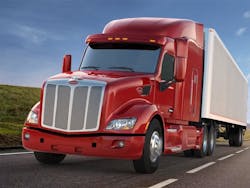DENTON, TX. With production of Peterbilt Motors’ all-new Model 579 now under way, the company extended an invitation to Fleet Owner to spend some time with its premium over-the-road tractor at the Peterbilt heavy-truck factory just north of Dallas. After a ride with two of the engineers involved in its development and a thorough technical walk-around, it’s clear that the Model 579 was carefully designed to please both fleets and their drivers.
Whether it’s major things like aerodynamic styling that maximizes fuel efficiency or smaller ones like pulling the dashboard forward and repositioning cup holders to make it easier to slip from the driver’s seat into the sleeper box, the Peterbilt team started their ground-up development of a new flagship tractor with eyes firmly on customer need and preferences.
“At the beginning of the project, we went and talked to fleets and their drivers and their service managers to make sure we clearly understood their requirements, what worked already with our current models, what they liked and disliked,” said Landon Sproull, Peterbilt chief engineer. Then the company “brought in customers over and over during the development process to keep checking,” he said.
Some design decisions driven by this research are invisible to fleets and drivers, though the results are not. For example, Peterbilt chose stamped aluminum for the cab because it lent stiffness to the truck’s structure helping to lower in-cab noise and vibration, two key attributes identified by users, according to Sproull. Similarly the cab is wider than other Peterbilt models, making it easier for a driver to move around.
The design of the 579’s doors is another area where choices not obvious to users impact their impression and satisfaction. “The door is our handshake with the driver,” said Sproull, who points to the 579’s triple seals mimicking the experience of closing the door on a premium automobile.
While computer design tools shaped the 579’s aerodynamic lines and identified ways to deliver a quieter truck, the engineering team also used some common-sense, practical techniques to satisfy the identified customer needs.
“At one point we took three weeks worth of a driver’s gear, laid it out and then designed purposeful storage for clothes, sleeping stuff, entertainment,” said Sproull. The result was what he calls an asymmetrical interior. “Instead of two wardrobes, for example, we have one and on the other side we have a work space for the driver. Our research told us having that work space in the sleeper was important to drivers. We even designed a draw specifically to fit a laptop.”
With minimizing operating cost high on the list for fleets, that was the top design objective for the 579, according to Peterbilt’s chief engineer. Major elements like maximizing aerodynamics for optimum fuel efficiency required analyzing every single exterior feature of the truck from mirror stalks to smaller fairings backing up side fairings. “We learned that some features that worked on older trucks wouldn’t work here, that there is no universally shared design when it comes to aerodynamics,” Sproull said.
Small things identified by fleet customers also contribute to that operating cost goal. For example, one option for the 579 is molded in colors for fenders and bumpers. “Fleets told us that means they don’t have to repaint fenders when it comes time to resell that tractor at the end of their trade cycle,” Sproull said. “That’s a big savings when you’re talking about dozens or hundreds of trucks.”
And while the Model 579 only exists as a single OTR tractor variant at the moment, future applications and customer were also part of the design motivation. The cab is the first Peterbilt model to use robotic bonding and state-of-the-art blind rivet fasteners like those used in airplane construction. “That not only helped hold down the weight for a larger cab, but also will allow us to put this cab into vocational applications later on,” Sproull said.
About the Author
Jim Mele
Jim Mele is a former longtime editor-in-chief of FleetOwner. He joined the magazine in 1986 and served as chief editor from 1999 to 2017.
